The Actinic Keratosis Treatment Market is estimated to be valued at USD 6.6 billion in 2025 and is projected to reach USD 13.2 billion by 2035, registering a compound annual growth rate (CAGR) of 7.1% over the forecast period.
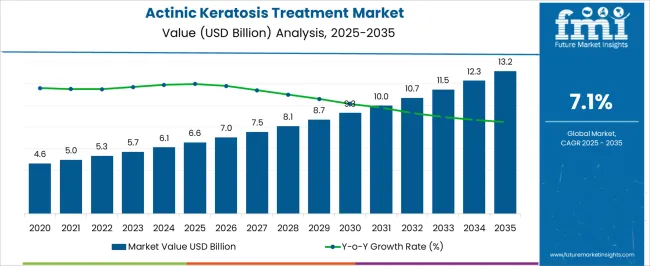
| Metric | Value |
|---|---|
| Actinic Keratosis Treatment Market Estimated Value in (2025 E) | USD 6.6 billion |
| Actinic Keratosis Treatment Market Forecast Value in (2035 F) | USD 13.2 billion |
| Forecast CAGR (2025 to 2035) | 7.1% |
The actinic keratosis (AK) treatment market is expanding steadily, supported by the rising prevalence of AK due to increased UV exposure, aging populations, and heightened dermatological awareness. Clinical studies and healthcare organization reports have emphasized early detection and treatment of AK to prevent progression to squamous cell carcinoma, which has boosted demand for effective therapies.
Pharmaceutical companies have expanded their portfolios with novel topical formulations, targeted therapies, and non-invasive procedures, reflecting a growing emphasis on patient-centric treatment approaches. Hospitals and dermatology clinics have also reported an increase in patient footfall due to heightened awareness campaigns and routine skin cancer screenings.
Regulatory approvals for advanced topical drugs and minimally invasive procedures have further broadened treatment options. Over the forecast period, market momentum is expected to be driven by innovations in topical therapies, cryotherapy advancements, and photodynamic therapy improvements. Segmental leadership is anticipated to remain concentrated in topical treatment, clinical AK diagnosis, and hospital-based care delivery due to accessibility, clinical efficacy, and integration into existing healthcare systems.
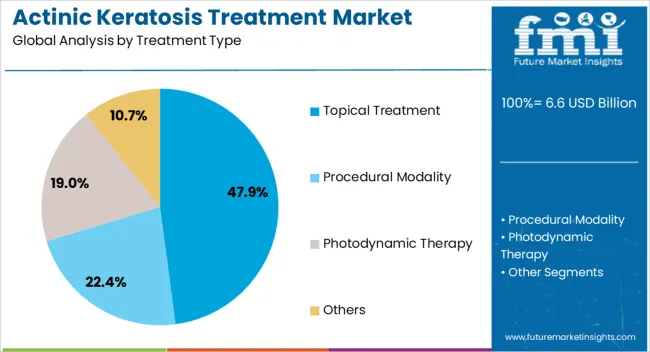
The topical treatment segment is projected to contribute 47.9% of the actinic keratosis treatment market revenue in 2025, sustaining its position as the leading treatment modality. Growth of this segment has been influenced by its non-invasive nature, ease of administration, and suitability for outpatient care.
Dermatologists have widely prescribed topical treatments due to their ability to target multiple lesions simultaneously, reducing the need for repeated clinical visits. Industry updates and clinical trial data have highlighted continuous improvements in formulations, including enhanced drug delivery mechanisms and reduced side effects, which have strengthened patient adherence.
Additionally, topical treatments have been preferred for their cost-effectiveness and compatibility with home-based care, expanding access to treatment in both developed and emerging markets. With increasing investment in new topical compounds and growing emphasis on self-managed care, this segment is expected to maintain its leadership position in the AK treatment market.
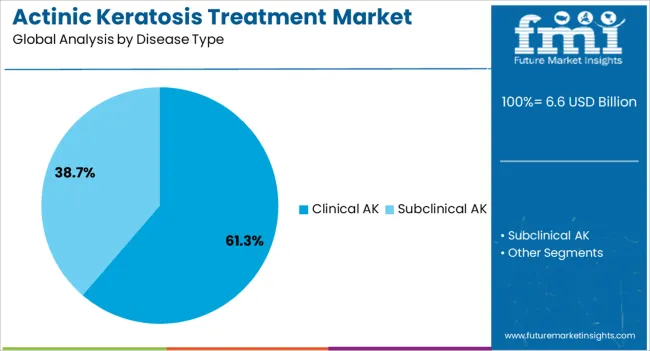
The clinical AK segment is projected to account for 61.3% of the actinic keratosis treatment market revenue in 2025, consolidating its position as the largest disease type category. This dominance has been attributed to the higher diagnosis and treatment rates of clinically visible AK compared to subclinical cases.
Dermatology journals have documented that clinical AK lesions are more likely to progress into squamous cell carcinoma, prompting timely therapeutic intervention. Hospitals and dermatology clinics have prioritized treatment of clinically evident AK due to its clear presentation and established treatment pathways, reinforcing its leading market share.
Furthermore, reimbursement frameworks in several countries have favored treatment of diagnosed clinical AK, boosting patient access. With rising awareness campaigns encouraging dermatological check-ups and increasing integration of digital diagnostic tools, clinical AK treatment demand is anticipated to remain strong, driving the segment’s continued leadership.
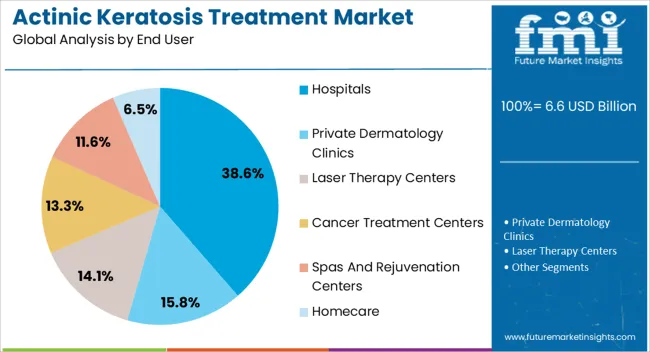
The hospitals segment is projected to hold 38.6% of the actinic keratosis treatment market revenue in 2025, retaining its position as the leading end-user category. Growth of this segment has been driven by the availability of comprehensive treatment facilities, specialized dermatology departments, and access to advanced diagnostic and therapeutic technologies.
Hospitals have been preferred by patients for managing AK due to the availability of multidisciplinary care, ensuring both accurate diagnosis and effective treatment. Press releases and annual reports from healthcare providers have indicated ongoing investments in dermatology infrastructure and photodynamic therapy units, strengthening hospitals’ role in AK care.
Moreover, hospitals have benefited from favorable reimbursement policies, increasing patient preference for hospital-based treatment over standalone clinics. With rising patient volumes, enhanced hospital resources, and integration of digital dermatology tools, the hospitals segment is expected to maintain its leadership role in AK treatment delivery.
Incidences of skin cancers have become a major industry driver. By providing early treatment like actinic keratosis, absolute improvements in patience were seen in recent years. For instance, the United States recorded 59,170 cases of melanoma in men and 41,470 among women in the first quarter of 2025.
Significant investment in research and development operations to provide innovative medicines with easier dosing, enhanced efficacy, and lower prices provide the appealing potential for individuals in the actinic keratosis treatment industry.
Alternative treatments are expected to hamper industry potential during the forecast horizon. With the availability of over-the-counter medications, individuals are actively choosing these types of affordable and temporary treatment options for recovery. Moreover, the lack of skilled medical professionals is emerging as a significant industry barrier in underdeveloped countries.
The high cost of treatment is setting up major barriers to sector growth. Treatments such as cryotherapy sessions and other topical medications can lead to the requirement of high out-of-pocket expenses. As a result, this financial burden is discouraging patients and limiting awareness of treatment options among individuals.
| Attributes | Details |
|---|---|
| By Treatment Type | Procedural Modality |
| Industry share in 2025 | 44.4% |
In light of offering a high level of control and precision in the removal of affected skin cells, the procedural modality segment is gaining popularity among individuals. Moreover, procedural modality is a preferred treatment option among dermatologists due to its versatility and ability to be tailored to the specific needs of each patient.
| Attributes | Details |
|---|---|
| By Disease Type | Clinical Actinic Keratosis |
| Industry Share in 2025 | 95.5% |
The growing number of clinical actinic keratosis cases is a primary factor in the actinic keratosis treatment market expansion. With the increasing prevalence of actinic keratosis, dermatologists are compelled to do more clinical diagnoses owing to increased awareness of the risk of disease progression to cancer. Rising awareness of the potential risks of clinical actinic keratosis lesions is likely to stimulate sector growth during the forecast period.
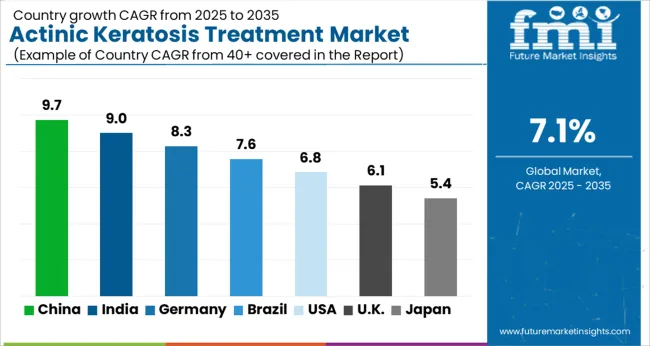
Actinic keratosis treatment industry as it shows significant potential in major regions, with Asia Pacific leading the way, followed by North America and Europe. India is taking the lead in sales, while Germany and the United States are also experiencing a gradual increase in demand. This indicates a promising future for the sector, and it's the perfect time for investors to consider this sector.
The actinic keratosis treatment market in the United States is poised for significant growth in the coming years, with an anticipated CAGR of 7.6%. The robust medical infrastructure in the country supports this positive outlook. The increasing prevalence of actinic keratosis was seen among the aging population in the United States. Individuals are highly aware of skin diseases in the country.
Surging medical advances contribute to the growth of the actinic keratosis treatment landscape in the United States. For instance, in 2025, the use of photodynamic therapy (PDT) along with photosensitization involving 5-aminolevulinic acid (ALA) and a Nano-emulsion has been authorized as a treatment for actinic keratosis in the United States.
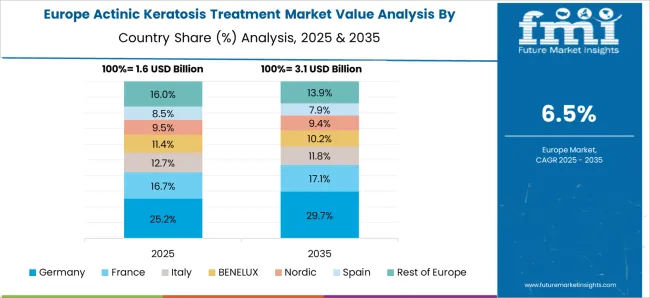
Germany’s actinic keratosis treatment market is poised for robust growth, with an expected 7.7% CAGR through 2035. Its cancer treatment landscape playing a significant role in shaping this trajectory.
According to sources, in Germany, the prevalence of actinic keratosis is observed to be higher among men (3.9%) than women (1.5%), and it increases with age, particularly in the 60-70 age group, where the rate is 11.5%.
As sun exposure is the main cause of actinic keratosis, manufacturers of preventive measures such as sun cream and other dermal creams are gaining the maximum industry share in the country. Additionally, strong healthcare infrastructure and government initiatives toward raising awareness of skin cancer are presumed to drive the industry in Germany.
The United Kingdom is expected to exhibit a promising CAGR of 7.3% in the actinic keratosis treatment market. Demand for non-invasive treatments is leading sector growth in the United Kingdom.
There is increasing awareness of the benefits of non-invasive treatments, such as shorter recovery times and less pain, in the United Kingdom. Hence, individuals are preferring this type of treatment solution in the country. Moreover, an increased number of cosmetic treatments have contributed to industry growth in the country in recent years.
India’s actinic keratosis treatment market is expected to witness a remarkable growth rate of 7.5%. The expanding number of patients affected by actinic keratosis is the primary driver of the industry.
Rising per capita spending on healthcare, along with increased research and development investment for innovative medicines, are likely to be the key factors shaping the industry in India. Moreover, the government is actively conducting various campaigns for cancer awareness and educating people through them.
Australia's actinic keratosis treatment market is projected to experience a strong growth trajectory, with a promising CAGR of 6.9% beyond 2025. This presents an exciting opportunity for investors and stakeholders to tap into the market's potential.
Increasing adoption of combination therapies, such as cryotherapy and topical methods, is actively driving sector growth in Australia in recent years. Also, technological advancements in healthcare have marked their own dominating position in the country, with newer modalities such as laser therapies and photodynamic therapies becoming popular.
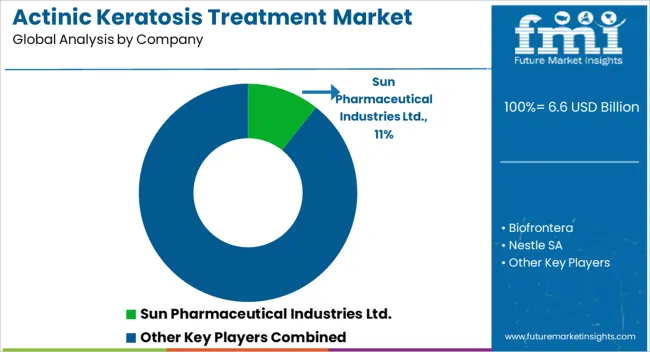
By developing effective and innovative treatment options, key actinic keratosis treatment market players are ready to gain a major industry share in the current period. Several key players are authenticating their treatment by getting government approvals to gain consumer trust. Moreover, pharmaceutical industry players are playing a major role in the industry by developing and supplying essential drugs and medicines.
Strategies for stakeholders to unlock industry potential
Recent Development
| Attribute | Details |
|---|---|
| Estimated Industry Size (2025) | USD 6,128.2 million |
| Projected Industry Size (2035) | USD 12,282.4 million |
| Anticipated Growth Rate (2025 to 2035) | 7.2% |
| Forecast Period | 2025 to 2035 |
| Historical Data Available for | 2020 to 2025 |
| Sector Analysis | USD million or billion for Value and Units for Volume |
| Key Regions Covered | North America; Latin America; Europe; Middle East & Africa (MEA); East Asia; South Asia and Oceania |
| Key Countries Covered | United States, Canada, Brazil, Mexico, Germany, Spain, Italy, France, United Kingdom, Russia, China, India, Australia & New Zealand, GCC Countries, and South Africa |
| Key Segments Covered | By Treatment Type, By Diseases Type, and By End User |
| Key Companies Profiled | 3M Health Care Ltd.; Alma Lasers Ltd.; Biofrontera AG; Bausch Health Companies Inc.; CryoConcepts LP; Cutera Inc.; DUSA Pharmaceuticals, Inc.; Galderma S.A.; LEO Pharma A/S; Novartis AG; Sun Pharmaceutical Industries Ltd.; Valeant Pharmaceuticals International, Inc. |
| Report Coverage | Sector Forecast, Company Share Analysis, Competition Intelligence, DROT Analysis, Sector Dynamics and Challenges, and Strategic Growth Initiatives |
Depending on the treatment type, the industry is categorized into a topical treatment and procedural modality. The topical treatment category is further divided into 5-fluorouracil cream, diclofenac gel, imiquimod cream, and ingenol mebutate gel. Also, procedural modality is divided into chemical peels, cryotherapy, photodynamic therapy, and others.
The actinic keratosis treatment is effective in clinical and subclinical disease types.
The key end-user industries are hospitals, private dermatology clinics, laser therapy centers, cancer treatment centers, spas and rejuvenation centers, and home care.
Regional analysis is conducted of the industry in North America, Latin America, Europe, South Asia, East Asia, and Oceania, as well as the Middle East and Africa.
The global actinic keratosis treatment market is estimated to be valued at USD 6.6 billion in 2025.
The market size for the actinic keratosis treatment market is projected to reach USD 13.2 billion by 2035.
The actinic keratosis treatment market is expected to grow at a 7.1% CAGR between 2025 and 2035.
The key product types in actinic keratosis treatment market are topical treatment, _5-fluorouracil cream, _diclofenac gel, _imiquimod cream, _ingenol mebutate gel, procedural modality, _chemical peels, _cryotherapy, photodynamic therapy and others.
In terms of disease type, clinical ak segment to command 61.3% share in the actinic keratosis treatment market in 2025.






Full Research Suite comprises of:
Market outlook & trends analysis
Interviews & case studies
Strategic recommendations
Vendor profiles & capabilities analysis
5-year forecasts
8 regions and 60+ country-level data splits
Market segment data splits
12 months of continuous data updates
DELIVERED AS:
PDF EXCEL ONLINE
Porokeratosis Treatment Market
Treatment-Resistant Hypertension Management Market Size and Share Forecast Outlook 2025 to 2035
Treatment-Resistant Depression Treatment Market Size and Share Forecast Outlook 2025 to 2035
Treatment Pumps Market Insights Growth & Demand Forecast 2025 to 2035
Pretreatment Coatings Market Size and Share Forecast Outlook 2025 to 2035
Air Treatment Ozone Generator Market Size and Share Forecast Outlook 2025 to 2035
CNS Treatment and Therapy Market Insights - Trends & Growth Forecast 2025 to 2035
Seed Treatment Materials Market Size and Share Forecast Outlook 2025 to 2035
Acne Treatment Solutions Market Size and Share Forecast Outlook 2025 to 2035
Scar Treatment Market Overview - Growth & Demand Forecast 2025 to 2035
Soil Treatment Chemicals Market
Water Treatment Market Size and Share Forecast Outlook 2025 to 2035
Water Treatment Ozone Generator Market Size and Share Forecast Outlook 2025 to 2035
Water Treatment Equipment Market Size and Share Forecast Outlook 2025 to 2035
Burns Treatment Market Overview – Growth, Demand & Forecast 2025 to 2035
CRBSI Treatment Market Insights - Growth, Trends & Forecast 2025 to 2035
Water Treatment Polymers Market Growth & Demand 2025 to 2035
Water Treatment System Market Growth - Trends & Forecast 2025 to 2035
Algae Treatment Chemical Market Growth – Trends & Forecast 2024-2034
Water Treatment Chemical Market Growth – Trends & Forecast 2024-2034

Thank you!
You will receive an email from our Business Development Manager. Please be sure to check your SPAM/JUNK folder too.
Chat With
MaRIA